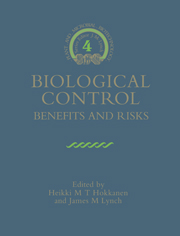Book contents
- Frontmatter
- Contents
- List of Contributors
- Series Preface
- Preface: Overview of Benefits and Risks of Biological Control Introductions
- Part I Biological Invasions
- Part II Classical Biocontrol
- Part III Augmentative Biocontrol
- 9 The Use of Exotic Organisms as Biopesticides: Some Issues
- 10 Use of Trichogramma in Maize – Estimating Environmental Risks
- 11 Entomopathogenic Nematodes in Biological Control: Feasibility, Perspectives and Possible Risks
- 12 Pseudomonads as Biocontrol Agents of Diseases Caused by Soil-borne Pathogens
- 13 Biological Control of Soil-borne Pathogens of Wheat: Benefits, Risks and Current Challenges
- 14 Genetically Engineered Fluorescent Pseudomonads for Improved Biocontrol of Plant Pathogens
- 15 Biological Control of Foliar Fungal Diseases
- 16 The Use of Fungi, Particularly Trichoderma spp. and Gliocladium spp., to Control Root Rot and Damping-off Diseases
- 17 Bacillus thuringiensis in Pest Control
- 18 Opportunities with Baculoviruses
- Part IV Use of Genetically Modified Organisms
- Part V Economics and Registration
- Index
15 - Biological Control of Foliar Fungal Diseases
Published online by Cambridge University Press: 07 May 2010
- Frontmatter
- Contents
- List of Contributors
- Series Preface
- Preface: Overview of Benefits and Risks of Biological Control Introductions
- Part I Biological Invasions
- Part II Classical Biocontrol
- Part III Augmentative Biocontrol
- 9 The Use of Exotic Organisms as Biopesticides: Some Issues
- 10 Use of Trichogramma in Maize – Estimating Environmental Risks
- 11 Entomopathogenic Nematodes in Biological Control: Feasibility, Perspectives and Possible Risks
- 12 Pseudomonads as Biocontrol Agents of Diseases Caused by Soil-borne Pathogens
- 13 Biological Control of Soil-borne Pathogens of Wheat: Benefits, Risks and Current Challenges
- 14 Genetically Engineered Fluorescent Pseudomonads for Improved Biocontrol of Plant Pathogens
- 15 Biological Control of Foliar Fungal Diseases
- 16 The Use of Fungi, Particularly Trichoderma spp. and Gliocladium spp., to Control Root Rot and Damping-off Diseases
- 17 Bacillus thuringiensis in Pest Control
- 18 Opportunities with Baculoviruses
- Part IV Use of Genetically Modified Organisms
- Part V Economics and Registration
- Index
Summary
Introduction
Currently the only one commercialized biological control product against foliar fungal diseases exists, namely, ‘Trichodex’ (Makhteshim Chemical Works) for the control of grey mould of cucumber, tomato and grapevine (Y. Elad, personal communication). A few other products based on fungi are in the final stage of development or registration. Therefore, this review will primarily deal with the state of the art, which ranges from interesting hypotheses to promising research achievements under controlled and natural conditions. Compared with research efforts on biological control of soil-borne diseases, biological control of foliar diseases has up till now received little attention. The main reason for this appears to be the relatively efficient control of many above-ground pathogens by aerial applications of fungicides, while soil-borne pathogens are more difficult targets.
Nowadays, however, the world-wide awareness of the potential danger to the environment from many currently available chemical control agents and the increasing occurrence of fungicide resistance in a number of foliar pathogens has boosted research aimed at alternative means of disease control. For instance, in the Netherlands, a ‘Multi-Year Crop Protection Plan’ has been launched in 1990. This aims at a reduction in total amount of pesticide used of at least 35% by 1995 and 50% by the year 2000 (Anonymous, 1991). More importantly, the average emissions (the average pesticide emissions (to air, soil/ground water, surface water) to the environment are to be reduced to 50% in 1995 and to 30% in the year 2000.
- Type
- Chapter
- Information
- Biological ControlBenefits and Risks, pp. 167 - 176Publisher: Cambridge University PressPrint publication year: 1995
- 2
- Cited by

